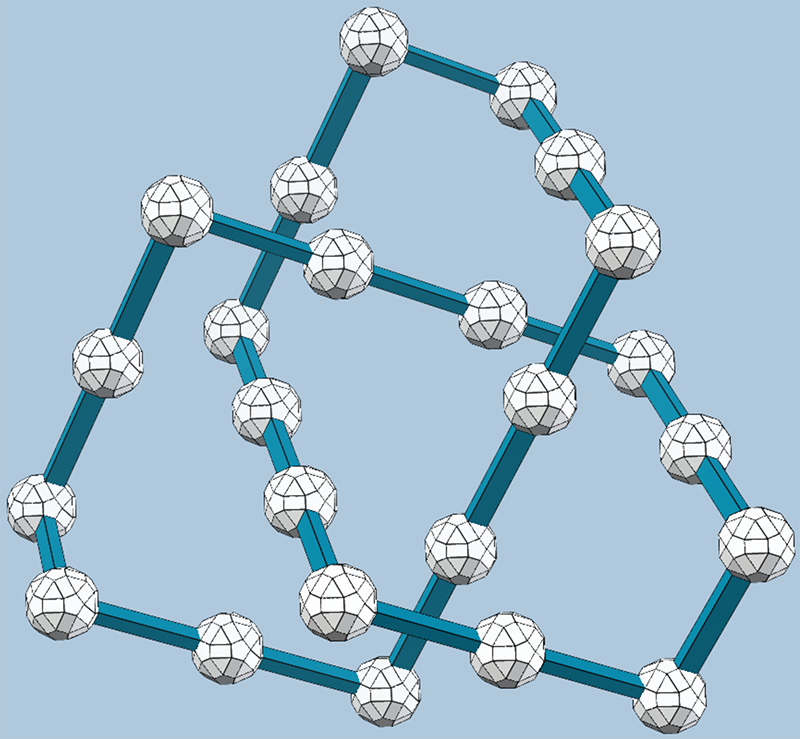Linkage
-
A 3-regular matchstick graph of girth 5 consisting of 54 vertices, Mike Winkler, Peter Dinkelacker, and Stefan Vogel (\(\mathbb{M}\)). The previous smallest-known graph with these properties had 180 vertices, but this one might still not be optimal, as the known lower bound is only 30. I found it difficult to understand the connectivity of the graph from its matchstick representation so I made another drawing of the same graph in a different style:
-
Saving public Google+ content at the Internet Archive (\(\mathbb{M}\), via). Archive.org and the Archive Team (a separate “loose collective of rogue archivists, programmers, writers and loudmouths dedicated to saving our digital heritage”) are undertaking an organized effort to capture it all before Google takes it down at the end of the month.
-
Symmetric minimality, Clayton Shonkwiler. An animation of a symmetric minimal-length grid realization of a trefoil knot, posted after I complained that his earlier animation was too asymmetric, and suggested using the realization below (drawn using vZome). Clayton also posted a bcc figure-8 and bcc \(7_7\). Not every symmetric knot has a symmetric lattice realization (e.g. the \((5,2)\) lattice knot doesn’t) but it may be an interesting question whether every lattice-realizable symmetry of a knot can be realized by a minimal lattice knot.

-
Karen Uhlenbeck becomes the first woman to win the Abel Prize (\(\mathbb{M}\)).
-
The curse of the Euclidean metric (\(\mathbb{M}\)). Krzysztof Fleszar posts about a big difficulty with algorithms for problems like Euclidean shortest paths where the answer is a sum of distances: we don’t know how to compare two solutions efficiently. Fortunately in the case of Krzysztof’s SODA 2019 paper on approximate TSP of hyperplanes (find a short tour that touches each given hyperplane) it’s possible to use approximate numerical comparisons.
-
Integer multiplication in time \(O(n\log n)\) (\(\mathbb{M}\), see also).
-
An odd couple of Los Angeles street art (\(\mathbb{M}\)): 20-something Inksap, a son of Vietnamese refugees, and 70-something dance teacher Linda Lack.
-
Brain-filling curves: A fractal bestiary (\(\mathbb{M}\)). A 200-page compendium by Jeffrey Ventrella of space-filling curves, generated by subdivision rules that expand line segments to lattice paths whose sum of squared edge lengths equals the square of the segment.
-
Automatically translate any 3d model into a zometool approximation of it (\(\mathbb{M}\), via). With obligatory Stanford bunny. See also their 1-minute video introduction.
-
Physicists are decoding math-y secrets of knitting to make bespoke materials (\(\mathbb{M}\)). Jennifer Ouelette writes on Ars Technica that by varying the stitching one can control both the stretchiness and shape of the resulting knit.
-
The MathML people are trying again (\(\mathbb{M}\), via). Much as I think MathML has failed and that promotion by its proponents after its failure was already obvious directly caused the continued bad mathematics rendering on Wikipedia, I wish them well. A working web mathematics markup language (if it can be achieved) would be a step up from Javascripted LaTeX. Of course I’m not about to give up LaTeX in my source but that’s what markup processors are for.
-
Chris Purcell asks “who is the mathematician/scientist who has the most Wikipedia citations without having a Wikipedia page?”. My guess is Heidi Burgiel, co-author of frequently-cited book The Symmetries of Things.
-
Deterministic 2048 (\(\mathbb{M}\)). The next tile is always a 2 at the first available square. It should be possible to describe a strategy that applies to any \(n\times n\) board and that provably achieves a score of \(2^{\omega(n)}\) but apparently this is not known.
-
Adam Sheffer points out that, despite recent advances in incidence geometry, many problems remain open, and sets out on a project to catalog them (\(\mathbb{M}\)). His starting points are the unit distances problem and incidences with nonlinear algebraic plane curves.
-
Why you should be keeping up with news and long-form websites using RSS rather than twitter (\(\mathbb{M}\), via). If you want to incorporate RSS feeds into your Mastodon stream, Darius Kazemi’s RSS-to-Mastodon tool looks useful, but I haven’t tried it, because so far I’m happy reading those feeds through NetNewsWire.
-
International Studies Association participants unable to get visas to go to their conference in Toronto (\(\mathbb{M}\)), a repeat of an issue I posted about for NeurIPS in January. According to the story, the proportion of participants with visa issues is similar to recent years when the conference has been in the US. Which is not a great target for Canada to aspire to…